The 980 PRO is Samsung’s top-shelf consumer PCIe 4.0 SSD, with read speeds up to 7GB/s and write up to 5GB/s. As we already reviewed this drive, this article focuses on the PlayStation 5-compatible heatsink version, and how it compares to the non-heatsink version under sustained load. In short, if you’re upgrading your PS5’s storage, the 980 PRO with heatsink is a fine choice, well worth the slight premium over the non-heatsink drive.
Samsung 980 PRO Heatsink Specifications
The Samsung 980 PRO with heatsink is available in 1TB and 2TB capacities for $189 and $349, nominal premiums of $20 and $21 over the non-heatsink drives. That’s high-end PCIe 4.0 SSD pricing, but per our reviews, it’s an excellent performer and worth the money. We observed that the 2TB version had slightly lower latency and much better write speeds (4.34GB/s versus 2.85GB/s in BlackMagic). Icing on the cake is that the 2TB version gives you slightly more storage for the money.
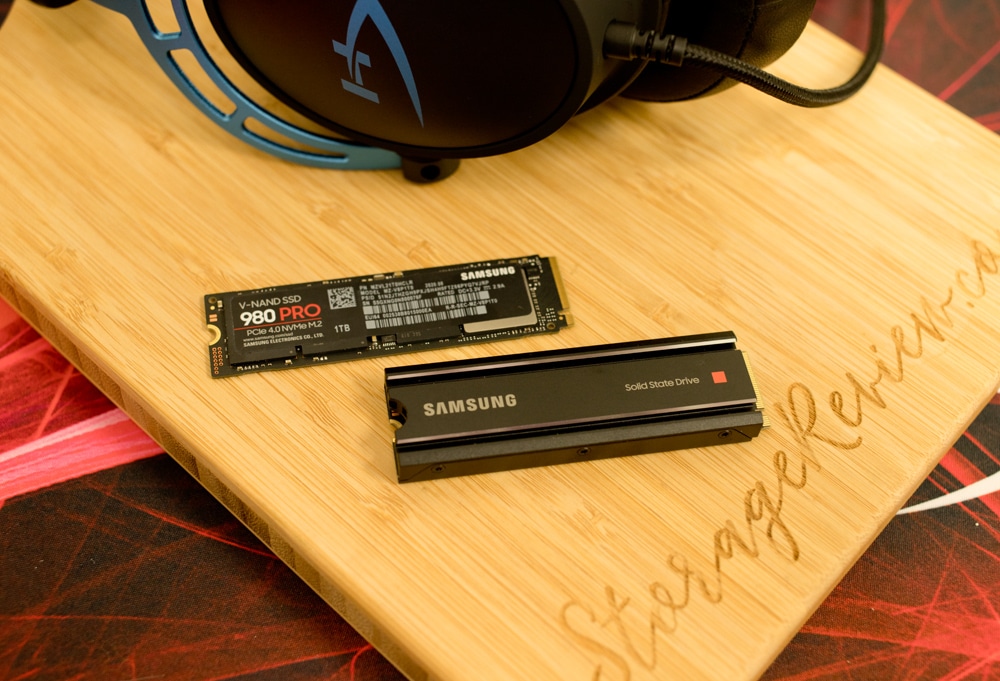
The 980 PRO Heatsink version under review can be used in a PC, but it won’t fit in a laptop due to the height of the heatsink, and many desktop motherboards will include heatsinks for the M.2 slots. Thus, the 980 PRO Heatsink version is mostly targeted at the PS5. Here you can see the heatsink’s 8.6mm thickness:
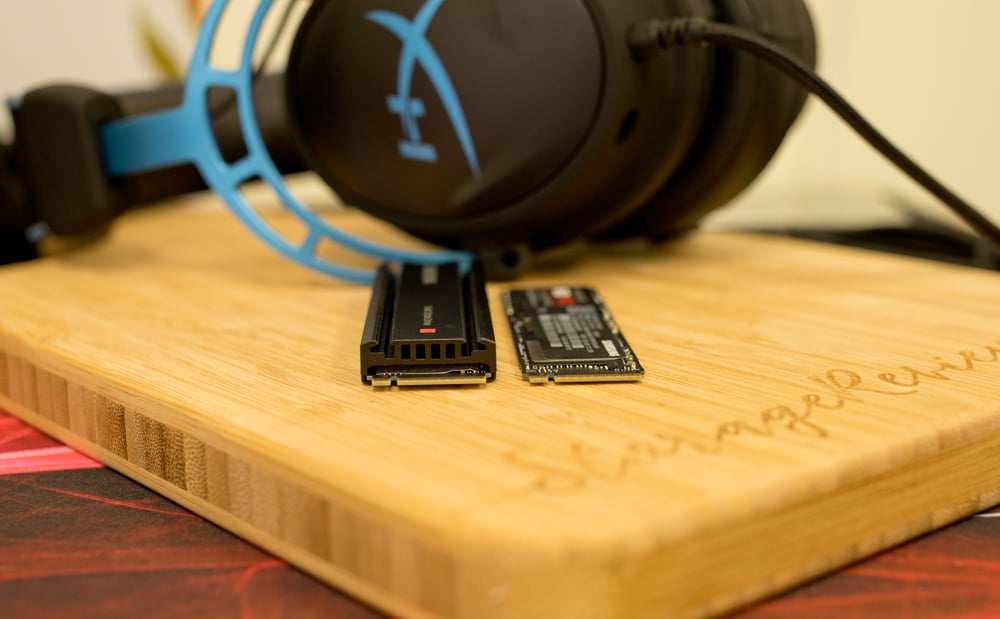
Why buy this drive with a heatsink? The PS5 has no active cooling to its M.2 slot, so anything that can be done to dissipate the heat is a good thing; an SSD will throttle its performance once it reaches a temperature threshold.
The full specifications of the Samsung 980 PRO with heatsink are as follows:
| Product Type | NVMe 1.3c SSD |
| Interface | PCIe 4.0 (Backwards-compatible with PCIe 3.0) |
| Capacity | 1TB or 2TB |
| Compatibility | PC & PlayStation 5 |
| Controller | Samsung Elipsis Controller |
| NAND Flash Memory | Samsung V-NAND 3bit MLC |
| DRAM Cache Memory | 1GB LPDDR4 (1TB drive) or 2GB LPDDR4 (2TB) |
| Encryption | AES 256-bit (SED), TCG V2.0, Encrypted Drive (IEEE1667) |
| Sequential Read/Write Speeds | 7000/5000MB/s |
| Trim Support | Supported |
| S.M.A.R.T. Support | Supported |
| Device Sleep Mode Support | Yes |
| GC (Garbage Collection) | Auto Garbage Collection Algorithm |
| WWN Support | Not supported |
| Thermal Protection | Heatsink |
| Average Power Consumption (system level) | *Average: 6.2 W*Maximum: 8.9 W (Burst mode)* Actual power consumption may vary depending on system hardware & configuration |
| Power Consumption (idle) | Max. 35 mW * Actual power consumption may vary depending on system hardware & configuration |
| Reliability (MTBF) | 1.5 million hours |
| Dimensions (with heatsink) | 24 by 80 by 8.6mm |
| Weight | Max 30.5g |
| Warranty | Limited 5 years |
Samsung 980 PRO Heatsink PlayStation 5 Installation
Installing the 980 PRO Heatsink in the PS5 isn’t difficult. It requires a small Philips-head screwdriver, preferably with a magnetic tip. Our experience was as follows:
- The PS5’s top cover comes off by prying one corner of the lid up and then sliding the entire cover upwards. Removing it requires a bit of force but nothing terrible.
- Remove the metal plate that covers the M.2 SSD slot. Installing the SSD is straightforward but be careful not to lose the small standoff and screw.
- Reassemble the PS5 and turn it on. You will be prompted to format the drive. You may get a warning that the drive isn’t fast enough on some slower drives. (The 980 PRO has no such issue.)
- Be sure to change it to the default download place if you intend to use it instead of the built-in drive.
Here’s the 980 PRO heatsink installed in our PS5. This drive is Type-2280 (80mm); the PS5 actually accepts up to Type-22110 (110mm) drives.
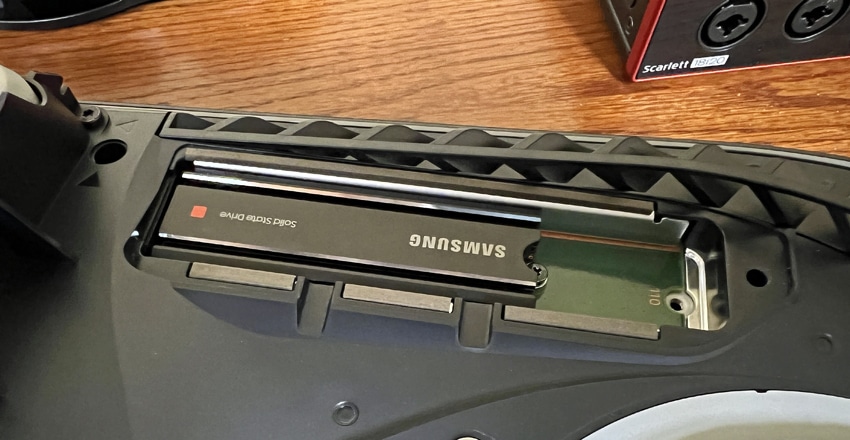
Samsung 980 PRO Heatsink Performance
For our performance testing, we pitted a 1TB Samsung 980 PRO Heatsink against a 1TB non-heatsink version and a 2TB non-heatsink version. All drives were updated to the latest firmware.
Our testing leverages the common vdBench workload generator, with a scripting engine to automate and capture results over a large compute testing cluster. This allows us to repeat the same workloads across a wide range of storage devices, including flash arrays and individual storage devices. Our testing process for these benchmarks fills the entire drive surface with data, then partitions a drive section equal to 5% of the drive capacity to simulate how the drive might respond to application workloads. This is different from full entropy tests which use 100% of the drive and take them into a steady state. As a result, these figures will reflect higher-sustained write speeds.
Profiles:
- 4K Random Read: 100% Read, 128 threads, 0-120% iorate
- 4K Random Write: 100% Write, 64 threads, 0-120% iorate
- 64K Sequential Read: 100% Read, 16 threads, 0-120% iorate
- 64K Sequential Write: 100% Write, 8 threads, 0-120% iorate
Our first test is 4K random read. The 1TB heatsink and the 1TB non-heatsink drives performed almost identically while the 2TB drive showed higher latencies than both. In other words, nothing out of the ordinary.
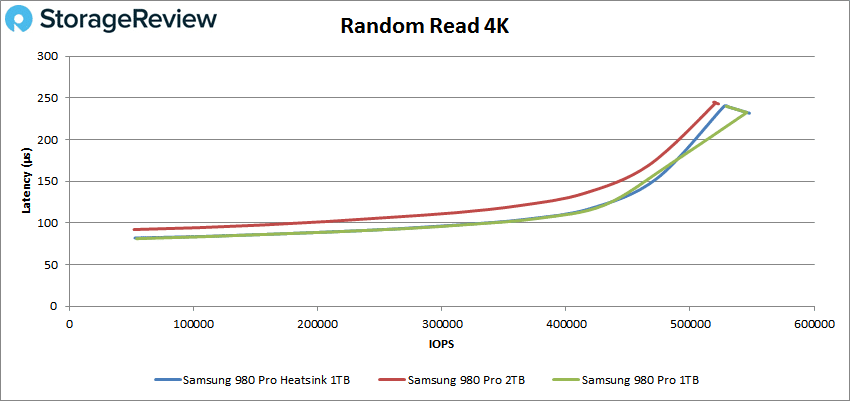
Next is 4K random write. The 2TB non-heatsink drive predictably outperformed the 1TB non-heatsink, but the surprise was that the 1TB heatsink drive significantly outperformed both of them. This may be the heatsink helping long-term performance, as these tests take several hours.
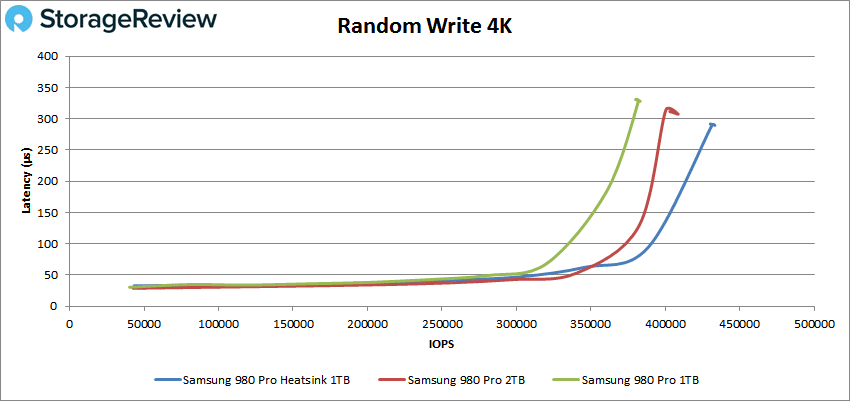
Now we’ll move onto sequential workloads. The drives behaved similarly here as they did in 4K random read, with the 2TB non-heatsink drive taking top honors. The 1TB drives stayed about even until higher throughputs where the heatsink drive showed a slight advantage.
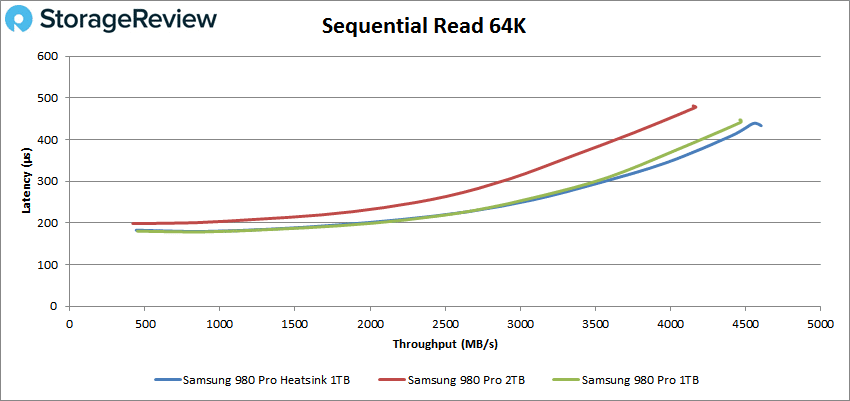
Last up is 64K sequential write. The 1TB heatsink drive showed the strongest performance here as it did in 4K random write, peaking at 1,990MB/s at 507µs latency. Given how long these tests run, it could be that the heatsink drive is able to maintain its performance better over time, as these drives were otherwise running identical firmware.
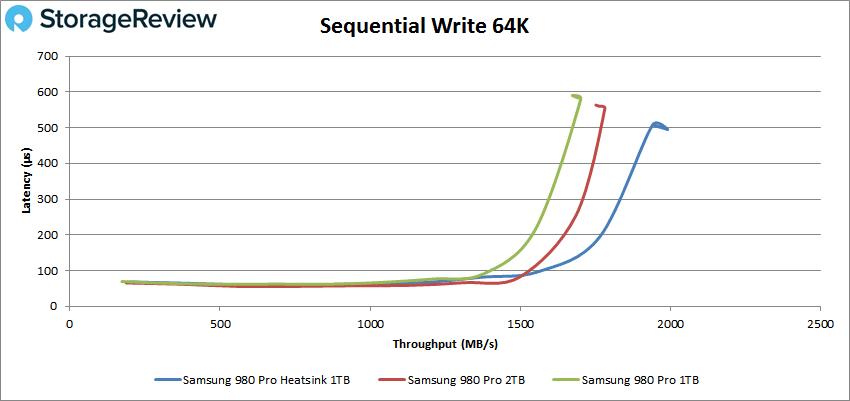
SSD with Heatsink Temperatures
To test the effectiveness of the 980 PRO’s heatsink, we ran a 2MB sequential write pattern to the 980 PRO Heatsink and non-heatsink drives, both 1TB versions updated to the latest firmware. We observed the drive’s reported internal temperatures using the Samsung Magician app. The ambient room temperature was 78 degrees F. We ran the test for 30 minutes to ensure the drives heated up.
As might be expected, the heatsink drive ran substantially cooler, finishing at 70 degrees C versus 79 degrees C for the non-heatsink drive. The screenshot below shows the two drives.
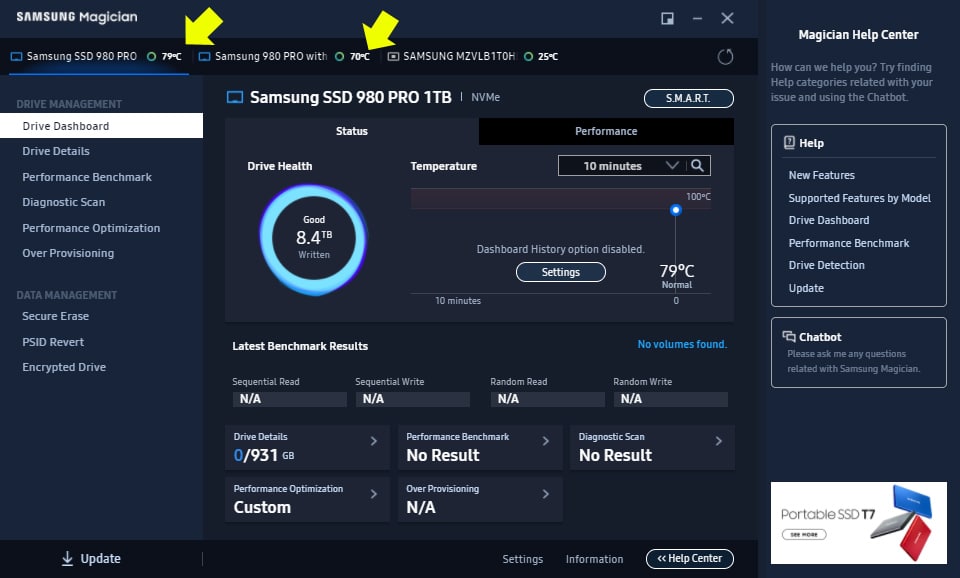
Conclusion
The PS5 has no active M.2 SSD cooling, so for long gaming sessions, the heatsink helps the drive’s temperatures stay in the optimal range. The drive will throttle its write performance if it gets too hot (likely, at or just over 80 degrees C) as will most SSDs, a risk that can be minimized with a heatsink. Electronics that run cooler tend to last longer, too.
Overall, the Samsung 980 PRO heatsink version is an ideal PlayStation 5 upgrade, combining excellent read/write performance with long-term thermal stability for a nominal premium (about $20) over the non-heatsink drive. Intriguingly, our 1TB heatsink drive showed significant write performance advantages over the non-heatsink 1TB and 2TB 980 PRO drives we tested alongside it, which is just icing on the cake for an already high-performance drive.




 Amazon
Amazon